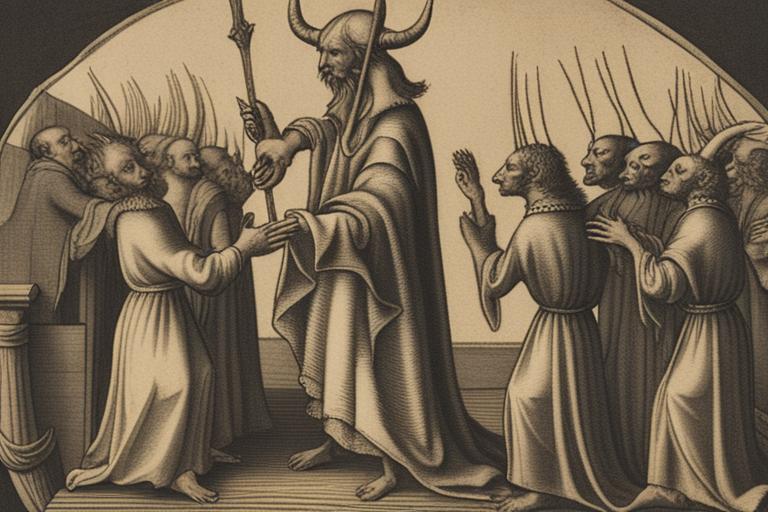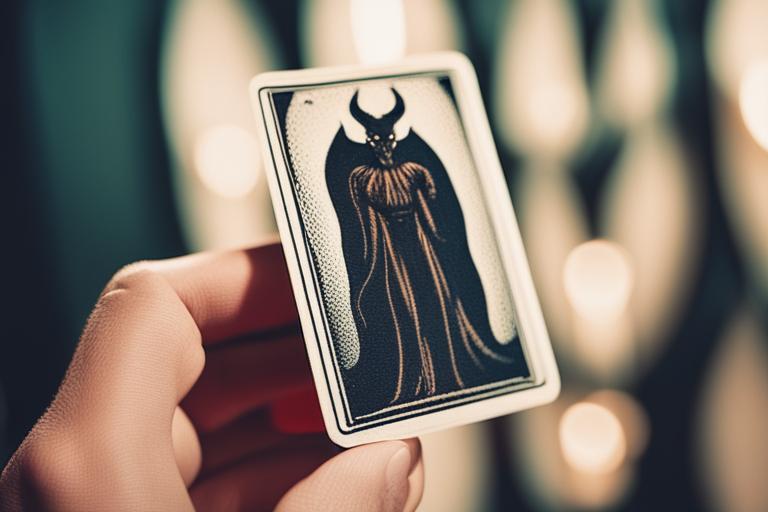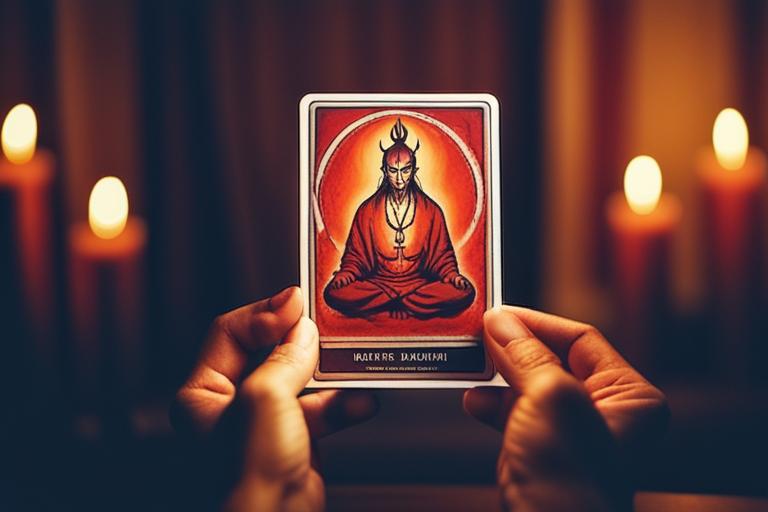Have you ever wondered about the symbolism of the Devil tarot card? This card is one of the most intriguing and sometimes misunderstood cards in the tarot deck. Although often associated with evil and temptation, the card actually holds a much deeper meaning in divination and spirituality. In this article, we will explore the history, symbolism, and interpretation of the Devil card, as well as its significance in both tarot readings and spiritual practices.

The History of the Devil Tarot Card
Tarot cards have a long and complex history, dating back to the 14th century when they were first used in Europe. Originally, tarot cards were used for playing games, but over time, they evolved into a tool for divination and spiritual exploration. The Devil card itself has gone through several transformations over the years, reflecting changes in society and the interpretation of its symbolism.
In the Rider-Waite tarot deck, the Devil is depicted as a horned, goat-like creature with bat wings and a torch in each hand. This image is inspired by the ancient Greek god Pan, who was associated with wildness, fertility, and the darker aspects of nature. In other tarot decks, the Devil may appear as a more human-like figure, or as a symbol such as a serpent or a dragon.
The Devil card is often associated with temptation, materialism, and addiction, but it can also represent power, sexuality, and personal transformation. Some interpretations of the card suggest that it represents the shadow side of the psyche, the part of ourselves that we keep hidden or repressed. Whatever its meaning, the Devil card has a powerful presence in the tarot and has inspired countless artists, writers, and spiritual seekers over the centuries.

Decoding the Symbolism and Importance of the Devil Tarot Card
- The Devil Tarot Card has a significant role in divination and spirituality.
- The history, meaning and interpretation of the card are discussed.
- The article also covers the role of the Devil card in shadow work and personal growth.

The Meaning and Interpretation of the Devil Tarot Card
| Tarot Deck | Image of the Devil Card | Interpretation |
|---|---|---|
| Rider-Waite | Horned, goat-like creature with bat wings and a torch in each hand | Representing wildness, fertility, and the darker aspects of nature |
| Deviant Moon | Insect-like creature with multiple eyes and legs | Symbolizing the chaotic and unpredictable nature of the card |
| Shadowscapes | Serpent entwined around a tree | Representing the temptation and seduction of the material world |
In a tarot reading, the Devil card can be a powerful and complex symbol, depending on its placement and the other cards in the spread. Traditionally, the Devil card is associated with bondage, addiction, and negative patterns of behavior. It can indicate a need to break free from unhealthy habits or relationships, or a warning to be careful of temptation and excess.
However, the Devil card can also be interpreted in a more positive light. It can represent the power of transformation and the ability to overcome fear and limitation. It may indicate a need to confront one’s fears and embrace the darker aspects of the self in order to move forward on a spiritual path.
Different tarot decks may offer different interpretations of the Devil card, depending on the artist’s vision and the cultural context. For example, in the Deviant Moon tarot deck, the Devil appears as an insect-like creature with multiple eyes and legs, representing the chaotic and unpredictable nature of the card. The Shadowscapes tarot deck depicts the Devil as a serpent entwined around a tree, symbolizing the temptation and seduction of the material world.

Understanding the Devil Tarot Card in Divination
When the Devil card appears in a tarot reading, its placement and surrounding cards can give clues to its meaning. For example, if the card appears in the past position, it may indicate a past experience of addiction or negative behavior that is affecting the present. If it appears in the future position, it may suggest a need to be more aware of temptation and negative patterns in order to avoid repeating past mistakes.
The Devil card can also appear in different positions in a tarot spread, such as the outcome or advice position. In these cases, it may indicate a need to confront one’s fears and limitations in order to move forward, or a warning to be careful of temptation and negative influences.
Interpreting the Devil card in a reading requires a deep understanding of its symbolism and context. It is important to approach the card with an open mind and a willingness to explore the shadow side of the self in order to gain greater insight and clarity.

The Devil Tarot Card in Spirituality
The Devil card is not only a powerful symbol in divination, but also in spirituality and personal growth. In many spiritual traditions, the Devil represents the shadow side of the self, the part that is repressed or denied in order to conform to societal norms. Embracing the shadow self and integrating it into one’s spiritual practice is an important part of personal transformation and growth.
The Devil card can be used in spiritual practices such as meditation and ritual work to explore the deeper aspects of the self. It can also be a powerful tool for shadow work, which involves facing and healing the parts of oneself that are difficult to acknowledge. By confronting the shadow self, one can gain greater self-awareness and spiritual insight.
Misconceptions and Controversies Surrounding the Devil Tarot Card
Despite its rich history and symbolism, the Devil card is often misunderstood and feared by some practitioners. Many people associate the card with evil or demonic forces, and avoid using it in their readings or spiritual practices.
However, it is important to remember that the Devil card is not inherently negative or evil. Rather, it represents the darker aspects of the self and the challenges that one must face in order to grow spiritually. By embracing the symbolism of the Devil card and exploring its deeper meanings, one can gain greater insight and clarity into their own spiritual journey.
It is important to note that some people may have concerns or objections to using the Devil card in divination or spiritual practices. While the card can be a powerful tool for personal growth, it may also trigger negative emotions or experiences for some individuals. It is important to approach the Devil card with sensitivity and respect for each individual’s unique spiritual journey.
Personal Story: How the Devil Card Helped Me Confront My Own Demons
As a tarot reader, I’ve always been intrigued by the Devil card. It’s one of the most misunderstood and feared cards in the deck, but it’s also one of the most powerful. I’ve seen it appear in readings in various contexts, from relationships to career to personal growth.
But it wasn’t until I did a reading for myself that I truly understood the significance of the Devil card. I had been struggling with addiction for years, and I knew deep down that it was time to confront my demons. When the Devil card appeared in my reading, I was initially taken aback. But as I studied the imagery and symbolism of the card, I began to see it in a new light.
The Devil card represents the shadow self, the parts of ourselves that we try to hide or suppress. It can also represent addiction, obsession, and unhealthy patterns. But it also reminds us that we have the power to break free from these patterns and confront our own darkness.
With the guidance of the Devil card, I was able to face my addiction head-on and begin the process of recovery. It wasn’t easy, and it took a lot of hard work, but the Devil card gave me the strength and courage to confront my own demons.
Now, whenever the Devil card appears in a reading, I’m reminded of my own journey and the power of confronting our shadow selves. The Devil card may be feared and misunderstood, but it’s also a powerful tool for personal growth and transformation.
Conclusion
The Devil Tarot Card is a complex and powerful symbol that holds deep meaning in divination and spirituality. By understanding its history, symbolism, and interpretation, we can gain greater insight into our own spiritual journey and personal growth. Whether used in a tarot reading or as a tool for shadow work, the Devil card can be a valuable and transformative tool for those seeking greater self-awareness and spiritual insight. However, it is important to approach the card with sensitivity and respect, and to be aware of any potential negative effects on individuals.
Questions and Answers
Q. Who is depicted on the devil tarot card?
A. A horned and winged creature resembling Satan.
Q. What does the devil tarot card represent in divination?
A. Temptation, materialism, addiction, and bondage.
Q. How can I interpret the devil tarot card in a reading?
A. Look at the surrounding cards and focus on the symbolism.
Q. What if the devil tarot card appears in a reading and I’m scared?
A. Remember that the card represents inner demons, not a literal devil.
Q. How can I use the devil tarot card for personal growth?
A. Reflect on areas of your life where you may be giving into temptation.
Q. What if I don’t believe in tarot or divination?
A. That’s okay, everyone has their own beliefs and practices.






